Butterfly Orchid Flower language, Phalaenopsis Culture method
Some friends like Phalaenopsis, but they don't know anything about Phalaenopsis breeding methods. Then the editor will introduce Phalaenopsis cultivation methods and the flower language of Phalaenopsis. I hope this information can explain to friends in need.

Butterfly orchid language
Different colors of Phalaenopsis represent different meanings. Let's take a look at the flower language of Phalaenopsis.
◆ White Phalaenopsis: love, Pure Friendship, Precious ◆ Yellow Phalaenopsis: developed career, prosperous Business
◆ Mini Phalaenopsis: happy Angel in its prime ◆ Phalaenopsis: everything goes according to plan
◆ Red Phalaenopsis: good luck knot forever ◆ Red Phalaenopsis: smooth and happy official career
◆ butterfly orchid language: I love you, happiness is coming to you

Culture methods of Phalaenopsis
I. temperature
Family breeding of Phalaenopsis, first of all to ensure the temperature. Phalaenopsis likes the environment of high temperature and high humidity, and the lowest temperature should be kept above 15 ℃ during the growth period. The suitable growth temperature of Phalaenopsis is 16-30 ℃. Therefore, attention should be paid to warming at the turn of autumn, winter and spring, as well as when the winter temperature is low.
In general, the temperature is easy to reach in a room with heating in winter, but be careful not to put flowers on or too close to the radiator. When the summer temperature is too high, we need to cool down, and pay attention to ventilation, if the temperature is higher than 32 ℃, Phalaenopsis will generally enter a semi-dormant state, to avoid continuous high temperature. The flowering period is around the Spring Festival, and proper cooling can prolong the viewing time. The night temperature during flowering should be controlled between 13 and 16 ℃, but not less than 13 ℃.

Second, watering
The origin of Phalaenopsis is in the primeval forest, with more fog and higher temperature. Phalaenopsis does not have thick pseudobulbs to store nutrients, and if there is not enough humidity in the air, the leaves will be wrinkled and weak. Therefore, Phalaenopsis had better be cultivated and maintained in a ventilated and humid environment.
The suitable air humidity for Phalaenopsis growth is 60%-80%. The new roots of Phalaenopsis should be watered more during the vigorous period of elongation and less during dormancy after flowering. The plants grow vigorously in spring and autumn around 05:00 in the afternoon, and the plants are watered at 09:00 and 05:00 every day. The light is weak and the temperature is low in winter. Watering every other week is enough. The best glue time is just before 10:00 in the morning.
When you encounter a cold wave, it is best not to water it. Keep the soil dry and resume watering after the cold wave. The principle of watering is to see dry and wet, and when the surface of the cultivation substrate becomes dry, water should be watered again, and the water temperature should be close to room temperature. When the indoor air is dry, the sprayer can be used to spray directly to the leaf surface to see that the leaf surface is wet. Note: do not spray water mist on flowers during flowering. Tap water should be stored for more than 72 hours before watering.

Third, lighting
Although Phalaenopsis prefers shade, it is still necessary to make Phalaenopsis plants receive some light, especially before and after flowering, appropriate light can promote Phalaenopsis to bloom, so the flowers are gorgeous and lasting, and should generally be placed indoors where there is scattered light. Do not let the sun shine directly.
IV. Ventilation
Phalaenopsis normal growth needs flowing fresh air, family breeding Phalaenopsis must be well ventilated, especially in the summer humid period, we must use good ventilation to prevent heat, so as to avoid the infection of diseases and insect pests.
V. Nutrition
Phalaenopsis should be fertilized all year round and should not be stopped unless the low temperature lasts for a long time. Winter is the flower bud differentiation period of Phalaenopsis. Stopping fertilization can easily lead to no flowers or few flowers. During spring and summer, thin liquid fertilizer can be applied every 7 to 10 days, preferably with organic fertilizer, or special nutrient solution for Phalaenopsis, but not when there are buds, otherwise it is easy to drop buds early.
Nitrogen and potash fertilizers can be applied after flowering. Phosphate fertilizer can be used in autumn and winter flower stem growth period, but it should be thin, about every 2-3 weeks. The time of fertilization is after watering in the afternoon, and after several times of fertilization, orchid pots and orchid plants should be washed with a lot of water to avoid residual inorganic salts harming the roots.

VI. Post-anthesis management
The florescence is usually around the Spring Festival, and the viewing period can be as long as 2-3 months. When the flowers wither, the withered flowers should be cut off as soon as possible, which can reduce the consumption of nutrients. If the flower stem is cut off from the base of 4-5 nodes, it can blossom again after 2-3 months. However, the nutrient consumption of the plant is too high, which is not conducive to the growth of the coming year.
If you want to blossom again in the coming year, it is best to cut the flower stem from the base, and when the matrix ages, it should be replaced in time, otherwise the air permeability becomes worse, which will cause root rot, weaken plant growth and even die. Generally speaking, it is appropriate to change the basin in May when the new leaves grow.
Summary: the above is the breeding method of Phalaenopsis, as well as the introduction of flower language, do you remember? Different varieties of Phalaenopsis will be different in details, we need to pay attention to. When carrying on the breeding, the flowers must be good and need to be taken care of carefully.
More information
| | what does white rose mean | what plant protects against computer radiation | geranium | cultivation methods and precautions of rhododendron | Golden orchid |
| | flowering period of lavender | Indoor foliage plants | Parthenocissus parthenocissus | folding method of lilies | efficacy and function of mint | Culture method of mimosa |
| | how to raise succulent plants | Osmanthus fragrans | efficacy and function of gynostemma pentaphyllum | hand-made roses | efficacy and function of honeysuckle | Kumquat |
VI. Post-anthesis management
The florescence is usually around the Spring Festival, and the viewing period can be as long as 2-3 months. When the flowers wither, the withered flowers should be cut off as soon as possible, which can reduce the consumption of nutrients. If the flower stem is cut off from the base of 4-5 nodes, it can blossom again after 2-3 months. However, the nutrient consumption of the plant is too high, which is not conducive to the growth of the coming year.
If you want to blossom again in the coming year, it is best to cut the flower stem from the base, and when the matrix ages, it should be replaced in time, otherwise the air permeability becomes worse, which will cause root rot, weaken plant growth and even die. Generally speaking, it is appropriate to change the basin in May when the new leaves grow.
Summary: the above is the breeding method of Phalaenopsis, as well as the introduction of flower language, do you remember? Different varieties of Phalaenopsis will be different in details, we need to pay attention to. When carrying on the breeding, the flowers must be good and need to be taken care of carefully.
More information
| | what does white rose mean | what plant protects against computer radiation | geranium | cultivation methods and precautions of rhododendron | Golden orchid |
| | flowering period of lavender | Indoor foliage plants | Parthenocissus parthenocissus | folding method of lilies | efficacy and function of mint | Culture method of mimosa |
| | how to raise succulent plants | Osmanthus fragrans | efficacy and function of gynostemma pentaphyllum | hand-made roses | efficacy and function of honeysuckle | Kumquat |
- Prev

Iron holly, an ornamental fruit tree species with multiple functions
Iron holly, an ornamental fruit tree species with multiple functions
- Next

The cultivation method of Lily of the valley, the appreciation of the pictures of the valley of the valley
The cultivation method of Lily of the valley, the appreciation of the pictures of the valley of the valley
Related
- Wuhan Hospital Iron Tree Blooming Result Was Instantly Frightened by the Gardener Master
- Which variety of camellia is the most fragrant and best? Which one do you like best?
- What is the small blue coat, the breeding methods and matters needing attention of the succulent plant
- Dormancy time and maintenance management of succulent plants during dormancy
- Minas succulent how to raise, Minas succulent plant pictures
- What are the varieties of winter succulent plants
- How to raise succulent plants in twelve rolls? let's take a look at some experience of breeding twelve rolls.
- Attention should be paid to water control for succulent plants during dormant period (winter and summer)
- Watering experience of twelve rolls of succulent plants
- Techniques for fertilizing succulent plants. An article will let you know how to fertilize succulent plants.

